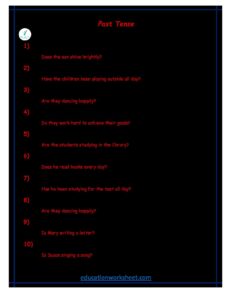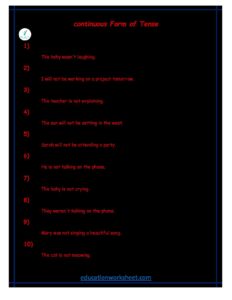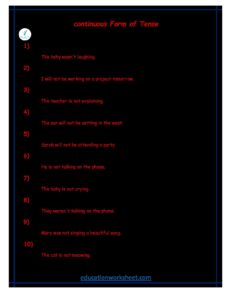how to converting continuous tense negative sentences to interrogative form
how to converting continuous tense negative sentences to interrogative form
Introduction
English tenses play a significant role in conveying the timing and nature of actions. The continuous tenses are used to describe ongoing or temporary actions. To transform negative sentences in continuous tenses into interrogative sentences, we need to understand the rules governing these tense structures and how to appropriately invert them to form questions.
Present Continuous Tense

The present continuous tense is used to describe actions that are happening right now or around the present time. To convert negative sentences in the present continuous tense to interrogative form, follow these steps:
Step 1: Identify the auxiliary verb in the negative sentence. In the present continuous tense, the auxiliary verb is “am,” “is,” or “are” (based on the subject).
Step 2: Place the auxiliary verb at the beginning of the sentence.
Step 3: Swap the positions of the auxiliary verb and the subject.
Step 4: Add a question mark at the end of the sentence.
Let’s illustrate this with an example:
Negative Sentence: He is not studying.
Interrogative Form: Is he not studying?
Here, we’ve simply moved the auxiliary verb “is” to the beginning of the sentence and switched its position with the subject “he.” Additionally, we’ve added a question mark to make it an interrogative sentence.
Past Continuous Tense

The past continuous tense describes actions that were ongoing in the past. To convert negative sentences in the past continuous tense to interrogative form, follow these steps:
Step 1: Identify the auxiliary verb in the negative sentence. In the past continuous tense, the auxiliary verb is “was” or “were” (based on the subject).
Step 2: Place the auxiliary verb at the beginning of the sentence.
Step 3: Swap the positions of the auxiliary verb and the subject.
Step 4: Add a question mark at the end of the sentence.
Let’s demonstrate this with an example:
Negative Sentence: They were not playing football.
Interrogative Form: Were they not playing football?
In this case, we’ve moved the auxiliary verb “were” to the front, exchanged it with the subject “they,” and added a question mark.
Future Continuous Tense

The future continuous tense indicates actions that will be ongoing at a specific time in the future. To convert negative sentences in the future continuous tense to interrogative form, follow these steps:
Step 1: Identify the auxiliary verb in the negative sentence. In the future continuous tense, the auxiliary verb is “will be.”
Step 2: Place the auxiliary verb “will be” at the beginning of the sentence.
Step 3: Swap the positions of the auxiliary verb and the subject.
Step 4: Add a question mark at the end of the sentence.
Let’s use an example to illustrate this transformation:
Negative Sentence: She will not be studying at 4 PM.
Interrogative Form: Will she not be studying at 4 PM?
In this instance, we’ve moved the auxiliary verb “will be” to the beginning, exchanged it with the subject “she,” and included a question mark to form an interrogative sentence.
Additional Considerations
- Negative Contractions: When converting a negative sentence to an interrogative form, it’s important to note that if the original negative sentence uses contractions (e.g., “isn’t,” “aren’t,” “wasn’t,” “won’t”), the contraction is often expanded to its full form when forming the question.
Negative Sentence (with contraction): They aren’t eating dinner. Interrogative Form: Are they not eating dinner?
- Word Order: In some cases, you can also create interrogative sentences by inverting the word order without changing the auxiliary verb’s form. This results in a different question structure:
Negative Sentence: You are not coming to the party. Interrogative Form (alternative): Are you not coming to the party?
- Politeness and Tag Questions: Interrogative forms can be used to express politeness or add tag questions to the end of sentences. For example, “Aren’t you coming to the party?” or “Isn’t it a beautiful day, isn’t it?” These structures are also used to confirm information.
Practice and Application
Converting continuous tense negative sentences to interrogative forms is a skill that requires practice. You can improve your understanding and application of this skill by practicing with various examples and tenses. Here are some additional examples to work with:
- Negative Sentence: I am not going to the concert. Interrogative Form: Am I not going to the concert?
- Negative Sentence: We were not watching a movie last night. Interrogative Form: Were we not watching a movie last night?
- Negative Sentence: She will not be taking the exam tomorrow. Interrogative Form: Will she not be taking the exam tomorrow?
- Negative Sentence: They aren’t swimming in the pool. Interrogative Form: Are they not swimming in the pool?
- Negative Sentence: He wasn’t playing the guitar when I called. Interrogative Form: Wasn’t he playing the guitar when I called?
By practicing with these examples, you can become more proficient at transforming negative sentences in continuous tenses into interrogative questions. This skill is valuable for effective communication and comprehension in English.

